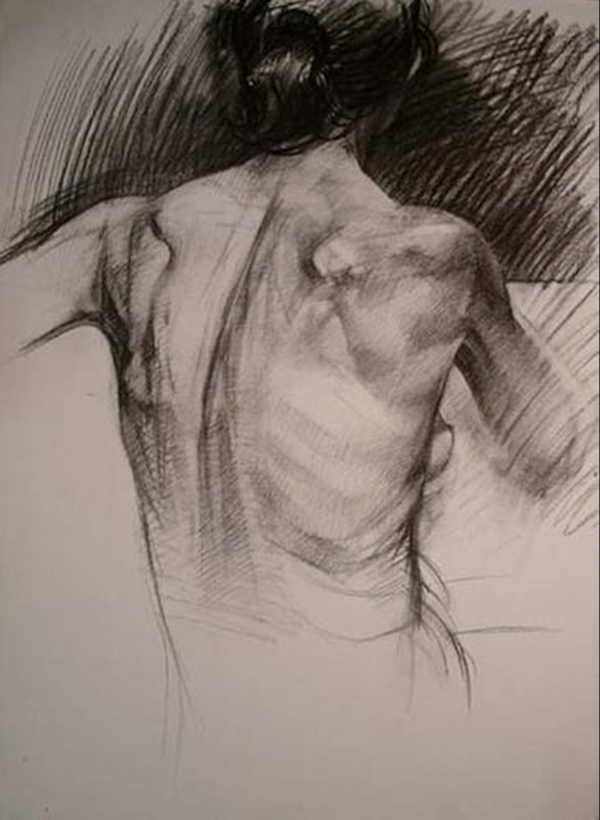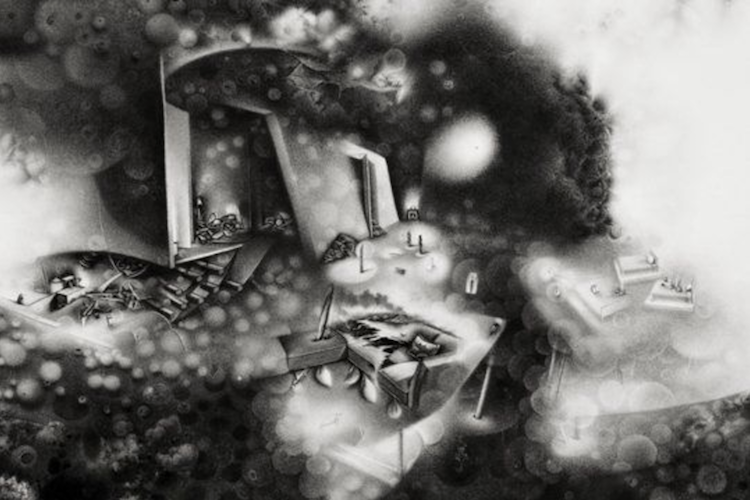White Charcoal Drawing On Black Paper
Must-Know Information for Choosing the Right Paper for Charcoal Drawing

Artists have drawn on virtually every kind of paper every produced. All types of drawing paper have their own unique characteristics. Some papers, like Bristol board, are more difficult to erase from. Others, like newsprint, are not archival. How a draftsman chooses a paper most often reflects what the drawing is meant to be or what it is being used for. Is it a study or preparatory drawing, mapping out ideas and experimenting with forms and composition? Is it a formal drawing in which every stroke is considered and choreographed? Is the artist after fine details? Or gestural marks that are fluid and loose? Should the paper be toned so the artist can add highlights and shadows to a surface that gives a consistent middle tone? Or is the artist more interested in the drama of dark marks against a completely white surface? These are the questions artists should ask as they embark on choosing a paper for drawing. For the purpose of this article, you'll discover guidelines and tips for how to choose the best paper for charcoal drawing, in particular.
Charcoal Explained
Charcoal is a highly reversible drawing medium. You can get rich dark tones out of it, with plenty of high contrast. The medium itself is known to inspire spontaneous and gestural marking as well as soft edges and smudging. Charcoal is a dry, dusty medium and tends to fly around on the page in a way that isn't terribly controllable. It is not associated with a delicacy of mark-making the way graphite is. And, it's often recommended to use spray fixative with charcoal to lock the medium in place. Want more great charcoal drawing techniques? Enter your email address in the box below for a free video tutorial on Charcoal Drawing Lessons. [fw-capture-inline campaign="" thanks="Thanks for downloading!" interest="Art" offer=""] Charcoal is made from slowly charred wood. Large vines are singed down in an airtight environment to make bigger sticks of charcoal. Thin willow twigs are charred for other smaller scale applications. Like graphite, charcoal comes in degrees of hardness and can also be found in pencil form.
Get That Paper
To select the best paper for charcoal drawing, you have to keep in mind the characteristics of the medium, as well as what you desire out of the drawing as a whole. Because charcoal is not a precision implement like, let's say a sharpened graphite pencil or ink pen, the best-suited surface for it is one with a lot of texture, akin to pastel boards, that will pull a lot of charcoal to its surface. You also want the surface to be durable. Paper for charcoal drawing should not be so delicate it won't stand up to being abraded with a kneaded eraser. Because it can remove stray marks and pick up extraneous (and inevitable!) charcoal dust to enhance highlights in a drawing, a kneaded eraser is a constant companion of charcoal.
It's Good for Charcoal Drawing If…
- It's newsprint. Newsprint is affordable and comes in a variety of sizes. However, it is fairly thin, so it can tear, pinch and buckle under strong pressure.
- It's made from cotton fibers. This is often the go-to paper for charcoal drawing and other dry media. It can be purchased in individual sheets and in pads or spiral bindings.
- It has tooth. Surface texture is also described as tooth–or how the surface holds the medium–whether it is graphite, charcoal or pastel. The softer your medium, the more tooth you want. Smooth paper is great for graphite, but it doesn't hold charcoal or pastel as well as drawing paper with a rougher texture.
- It's called charcoal or pastel paper. It will have the texture you want. Canson Mi-Teintes, Canson Ingres, Strathmore 500 Series and Fabriano Tiziano are popular choices.
- It's 60-90 lb. Suitable paper for charcoal drawing and other dry media are typically in this range. Heavier paper can stand up to vigorous mark-making and erasing, which are both hallmarks of charcoal drawing.
Smooth vs. Rough Drawing Papers

Smooth surfaces, like hot-pressed paper or Bristol board, will showcase highly detailed line work. These are not ideal for charcoal drawing because the powdery, crumbly charcoal does not have anywhere to cling on such a slick, texture-less surface. Rough and heavily textured paper, including pastel boards, will pull off the pigment of your drawing instrument and are much better suited to charcoal. Smooth drawing papers allow you to erase fairly easily, but the surface may bear the marks of removal. **Drawing Tip** It is often best to try to erase on a scrap piece of paper. You'll have a better idea of the results you'll encounter before going directly into your in-progress drawing with an eraser you have not worked with before. Rough, heavy and textured drawing papers are ideal for charcoal drawing. If you work with charcoal or pastel, your paper will often need to be sprayed with a fixative to lock the medium in place. Experiment with the fixative, especially the spray angle and distance from the surface, to ensure you get results you desire. And it is always a good idea to spray a test piece of paper. You will get a sense of how the fixative will affect the color and surface texture of your drawing.
Color Matters
Toned paper can definitely enhance a drawing but be sure to try out several colors until you find the overall color temperature and value that suits you and your subject. There are papers of every color of the rainbow, and charcoal works with some better than others.

Black papers with white markings are quite dramatic, but this isn't the ideal color for black charcoal as the medium virtually disappears on this surface, but using white charcoal is always a possibility. Blue papers are also a very classic, historic choice, prized by many academicians and contemporary draftsmen alike. It was used by Italian Renaissance artists first but its appeal spread across European in the following centuries and is still manufactured today. Our fearless leader, Courtney Jordan, prefers gray toned papers. It offers the artist the opportunity to better judge values, to create darker darks, and to add highlights for dramatic effects. Working on toned paper helps harmonize your colors because everything will have the same color base. Gray papers with a mix of black and white charcoal marks could have a lot of visual impact, but be aware that it takes work to keep the two separate so you don't create a gray-on-gray drawing. There's nothing quite like a crisp, pristine white paper. For charcoal, it can't be beat in terms of impact. But, it will show everything, so be bold and embrace every gestural line as you put it down.
Paper Qualities 101
What are the qualities to be aware of when it comes to paper? Here are a few to keep in the back of your head as you search for your paper.

- "Ply" indicates the thickness of a sheet of paper. The higher the ply number, the thicker the paper. Because charcoal drawing is often a "big gesture" process, thicker paper is the wiser choice as it stands up to that kind of pressure.
- Sizing is not as much of an issue when searching for a paper for charcoal drawing as level of absorption is not a concern.
- Look for "acid-free" paper. This paper type should have a neutral–and archivah–pH level of seven.
- Make sure any drawing you are creating as a finished work, as opposed to working drawings or sketches, is on lightfast paper.
- Semi-transparent papers can be used to create complex levels of overlapping images. However, be aware that using charcoal on this paper is tricky. You have to be careful about smudging and using varied pressure so you get half-tones and full-tones.
- When you are out paper shopping, touch the surfaces yourself. Textures will vary by manufacturer. A "vellum finish" from one brand might feel different than that of another paper maker. Usually, stores will allow you to test the paper, so bring your charcoal stick and let the marks fly!
**Drawing Tip** If you press hard into your paper but worry about the underlying surface being too unyielding, remember you can always put something between the surface and your paper—a scrap stack of paper, newsprint or even a sheet of linoleum, in the case of artist Julian Farrar, who works with large-scale charcoal drawings. *Article contributions by Courtney Jordan
***
Want More Expert Insight into Charcoal Drawing?
Check out this quick and easy blending tutorial using charcoal and an array of different materials from artist Alain Picard. Blending is a great way to add soft, quiet value changes and gradations when you want to establish shadowy and airy aspects in your drawings.
White Charcoal Drawing On Black Paper
Source: https://www.artistsnetwork.com/art-mediums/drawing/best-paper-for-charcoal-drawing/
Posted by: millervoymaiden.blogspot.com

0 Response to "White Charcoal Drawing On Black Paper"
Post a Comment